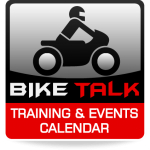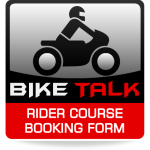It is often said that the delivery bike rider is asked whether he has a licence, given the bike, keys and a helmet and off he goes – Do you believe this is true?
In some cases this is very real and indeed a major concern. These delivery riders are shown the very basics by fellow riders, and put out on the roads with a mere Learner License or none at all. As for riding gear nothing special apart from a useless R500-R600 helmet, and maybe a rain suit or a hi-vis vest. Companies employing delivery riders or motorcycle fleet owners are in for a huge surprise if and when they don’t take the lives of these men and women seriously. To give an example: Company X here in Durban had an incident where one of their riders was involved in a motorcycle accident early 2014, and died due to his injuries. The family turned and took the Company (Employer) to court, claiming that the company never equipped the rider with the necessary personal safety gear and training. This oversight cost the company a pretty penny, and since then, became the benchmark for all delivery riders employed and in service on motorcycles.
I’ve seen over the following months, a number of fleet owners sending their riders for proper training and kitting them out with the required safety gear. Well-done to this family, and may this be the beginning of change for those running the gauntlet every day.
What are the requirements for a delivery biker with regards to an effective delivery vehicle – what do you believe should companies consider with regards to engine size of a bike etc.?
I deal with fleets all the time and noticed a trend where almost every one of these companies are out to buy the cheapest piece of scrap, reflecting a very short term and inconsiderate attitude toward their own pockets and the lives of others.
I’ll keep this short – most deliver riders are older than 18 years of age, and if he/she is still riding on a learner license will need to do the K53 Motorcycle Test on a motorcycle with an engine capacity bigger than 125cc (150cc and up) or they will be licensed as a Code A1 rider, licensed to ride a motorcycle of up to and including 125cc. Putting him/her on a scooter with a Learner License, and when sending him/her for the Test, will only be licensed to ride an automatic “gear box” motorcycle/scooter.
Some thinking and forward planning will save the employer/company a lot of time and money in the long run. It really depends on the rider’s status and the employer requirements for service delivery.
- There is not a big price difference between a 125cc and a 150/200cc motorcycle. Spend the extra cash and save in the long run. I’m not here to discuss or recommend brands, but these bikes are out there and available from reputable dealers nationwide.
- I generally recommend that a rider be put on a motorcycle nothing smaller than a 200cc if he/she will be riding on a Freeway where other road users are travelling at an average speed of 110-120km/h. This engine capacity has enough power to maintain these speeds without straining the motor beyond its performance boundaries. The total daily travelling distance should also be considered.
- If however the rider will be operating mostly within city limits on urban roads at a maximum of 60km/h, a 125cc motorcycle will suffice.
Expecting a rider to operate a motorcycle beyond its performance limits will not only push the motorcycle to destruction, but also stretch the rider and his/her abilities outside their comfort zone. Further to this it is proven that small diameter wheeled scooters are prone to a higher accident rate due to a few factors. Rather invest in a big/normal diameter wheeled motorcycle or scooter which gives added stability and handling or dealing with our road conditions.
The delivery guy has to operate effectively in urban areas – are there specific skills and techniques required?
Skills are taught and only obtained by a select and committed few. Here are a few very basic tips these brave souls can take notice of if they wish:
- Keep your following distance and keep your levers (brakes and clutch) covered at all times, ready to react if you need to.
- Lane split with caution, nothing faster than 10km/h to the other stationary road users.
- Always have an escape route and never ride next to another road user or in his/her blind spot.
- Ride with your high-beam on at all times, and make yourself visible to other road users.
- Keep to the legal speed limit, I know it is difficult, but why rush and put your life and that of others at risk.
- Ask your employer to send you for a suitable Rider Training Course; it could save your life, save him money and make him look like a caring and concerned individual.
Ride to Live! It is you on the motorcycle, not your employer – Take Care of Yourself!
Are you aware of typical types of crashes involving our delivery bikers?
There are four very distinct accidents that jump to mind but nothing different from a regular daily commuter on a motorcycle:
- Rear-ending another road user due to lack of anticipation
- Being rear-ended by another road user due to cutting and braking
- Being pushed off the road due to lack of anticipation and awareness
- And then the very famous T-bone, bike hitting car or car hitting bike due to ignorance
Are there specific bike checks you would advise before a day at work for the delivery guy?
A good pre-trip inspection is as good as the person conducting it, and how regular it is done. A daily inspection is very important and should be seen as taking out a life insurance policy. Here is a common method of a good pre-trip inspection:
T – Tyres & Wheels
C – Controls
L – Lights
O – Oil
C – Chassis
S – Stands
A more comprehensive explanation of each pre-check item can be downloaded HERE
 What would be the most important aspects to consider with regards to the load carried – where to carry / where not to / weight distribution etc.
What would be the most important aspects to consider with regards to the load carried – where to carry / where not to / weight distribution etc.
Legally any load on a motorcycle may be carried on the tank with the use of a proper tank-bag but not obscuring the view of the rider or hampering the safe operation of the motorcycle.
The most common place for the load on a delivery motorcycle, is by means of a suitable and purpose built box affixed to the back of the motorcycle held in place by a steel or metal bracket, and in turn affixed to the frame of the motorcycle. The box should be mounted over the passenger seat or directly above the rear axle so as to not alter the handling or road holding of the motorcycle. The box should be of a manageable size to not create a “sail” effect, pose a risk to the rider or make the motorcycle unstable when placed on its side-stand. Most reputable dealers have these guidelines and should stick to them no matter what.
Heavier goods should be placed at the bottom of the box and lighter items to the top. An additional method is panniers or better known as saddlebags. This way the load is low down and near (next or above) the rear wheel or axle.
If there are several guys doing deliveries and several bikes – how important is it to have a “dedicated” bike for a specific delivery guy?
Good point! Most employers do issue each rider with his or her motorcycle, leaving the responsibility to one person; the rider. Sure there will be initial little adjustments that will have to be made like seat height, mirror setup, brake and clutch lever setup, etc.
Only when change in employment occurs will these items have to be looked at again, or when it returns from a scheduled service or repair.
A dedicated motorcycle provides the operator with confidence purely because he knows the motorcycle inside and out – His home away from home!
Are there specific considerations with regards to protective clothing to take into account – does he have to wear “ALL the protective Gear” or what would you regard as the most important essentials? [weather / visibility etc…]
ATGATT (All The Gear All The Time) should not only apply to the “other” motorcycle riders on our roads, but to EVERY one operating a motorcycle, and that includes these brave young men and women.
If skin is exposed it needs to be covered, and compromising on any item leaves room to chance. The everyday commuter or delivery rider needs to make him/her -self super visible and putting reflective tape on the motorcycle or box and wearing a hi-vis vest or rain suit can and will increase your chance of survival in this jungle.
Let others laugh and call you a “Power Ranger”; it is your life, take it serious and dress for the fall not the ride.
Any other aspects you as an instructor believe could add to the safety of the Bike delivery rider?
I can only say because it is easier to talk than to put myself in their boots or shoes, having to deal with a difficult employer. Insist or ask nicely: “Mr Employer, I am a human being, I have a family and value my life, please look after me and I promise I will look after you and your customers.”
Ask to be geared-up and trained-up properly, and if you feel your life is at risk, look for a position elsewhere. Your life is more important!
This has been an interview by Johan Jonck of Arrive Alive












